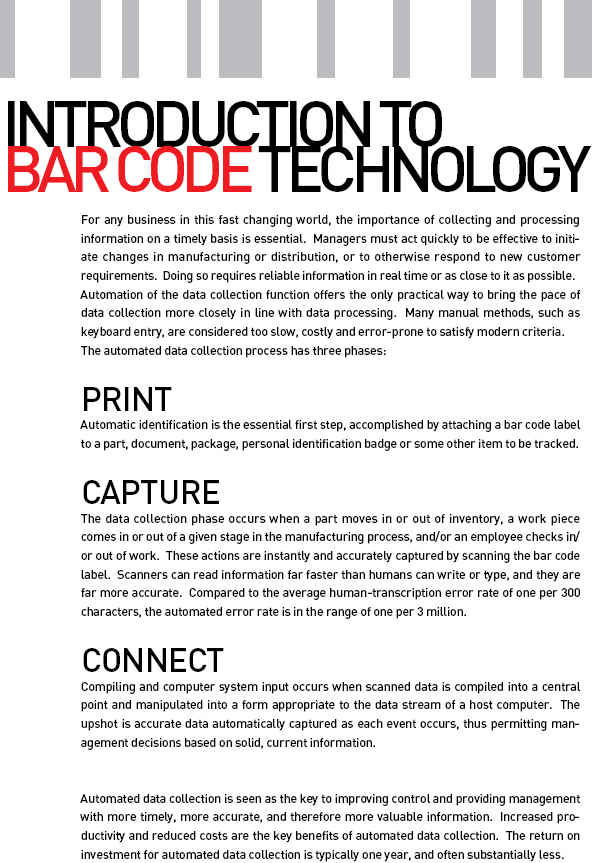
By Adrian Bastow

In the midst of the recent RFID craze, it is important not to overlook its worthy forerunner: the bar code. RFID represents a valuable breakthrough in automatic identification and data collection technology. Nonetheless, nearly forty years after the first commercial use of the bar code in 1966, it remains a trusted technology with sustained value across many sectors, including retail, healthcare, packaging, transport, public procurement and defence, computers and manufacturers.
WHAT IS BAR CODE?
The bar code was originally conceived in the United States to facilitate identification of products in the supermarket and railroad industries by eliminating manual key entry. Bar codes consist of a series of alternating bars and spaces printed or stamped on parts, containers, labels, or other media, representing encoded information that can be read by electronic readers for accurate data input to computer systems. One of the advantages of using bar codes over normal language characters is that bar codes can be easily scanned and read by a computer, whereas characters cannot. The theory behind bar coding is to encode a unique identification number for an item that can be recognized by a reader, of which there are four types: laser, linear, 2D imaging and video imaging. 2D bar codes, which can hold about 2,000 bytes of data, store data along two dimensions, making use of the vertical as well as the horizontal dimension to carry more data. The main function of a bar code is to identify a given item, not to provide detailed information about the item. After identifying a product with a bar code, the code can then be used to find information in a database. The bar code system requires widespread agreement between suppliers and recipients regarding which bar codes and numbers are used. Although there are several forms of bar codes, the most widely used standard is the European Article Numbering (EAN).Uniform Code Council (UCC). Once a company registers with EAN International, the company receives an assigned bar code prefix to use in identifying all products. The company is then responsible for allocating a unique number to each product from the number bank associated with the company prefix. Today over one million companies operate under the EAN.UCC system.
The Value of the Bar Code
Over the past decade, bar code technology has proved its worth as an enabling technology that contributes to manufacturing cost reduction, quality improvement, cycle-time reduction and improved profitability. The value of the bar code lies in its accuracy and efficiency. It is an incredibly robust, reliable technology that costs virtual pence to produce and yields high returns on investment. Bar coding is critical to monitoring the flow of goods through the supply chain. Using bar codes, companies minimize time monitoring the progress of shipments across the transport network. Bar codes enable tracking of individual consignments and automatically capture product movement data at dispatch points, on packing lines, in warehouses and at delivery points. This allows transport providers and their customers to know precisely when goods are shipped, where they are in the transport pipeline and when they will be delivered.
FULFILLING THE NEED
Despite the advances enabled with RFID, bar codes are still ideal to fulfill the majority of automatic identification needs today. However, RFID is superior to bar codes under certain circumstances, such as situations that involve simultaneous reading of multiples tags, those in which there is no line of sight between the reader and the tag, or those in which a label may need to be altered over time. One key benefit of RFID is speed -- an RFID tag can be read and communicate data in milliseconds. Taking into account the many advantages of RFID, there are many applications for which it is cost efficient to use barcodes over RFID. Due to the expense of producing and assembling the silicon chip and antenna needed for an RFID tag, the cost of a single RFID tag can be relatively high. On the other hand, bar codes are extremely inexpensive to produce and supply dependable automatic identification information. Higher unit levels, such as loads or pallets may justify the cost of RFID tags, but for individual items, depending on the profit margin with the particular item and the specific application needs involved and the value of the information gained, bar codes may be a more practical choice.
RFID should not be viewed as a replacement for the bar code, rather the two are complementary data capture technologies that can work in tandem to produce desired results. Even when RFID is adopted on a largescale, it is likely that RFID and bar codes will coexist. Bar codes are inexpensive and effective for many tasks, so the need for bar codes will continue into the future. As with all technology, automatic identification technology constantly evolves and will continue to do so to meet the data collection and processing needs of a fastchanging business world.
Adrian Bastow is Global Field Marketing Director of Intermec Technologies (http://www.intermec.com/).
For more information, please send your e-mails to swm@infothe.com.
¨Ï2007 www.SecurityWorldMag.com. All rights reserved. |



